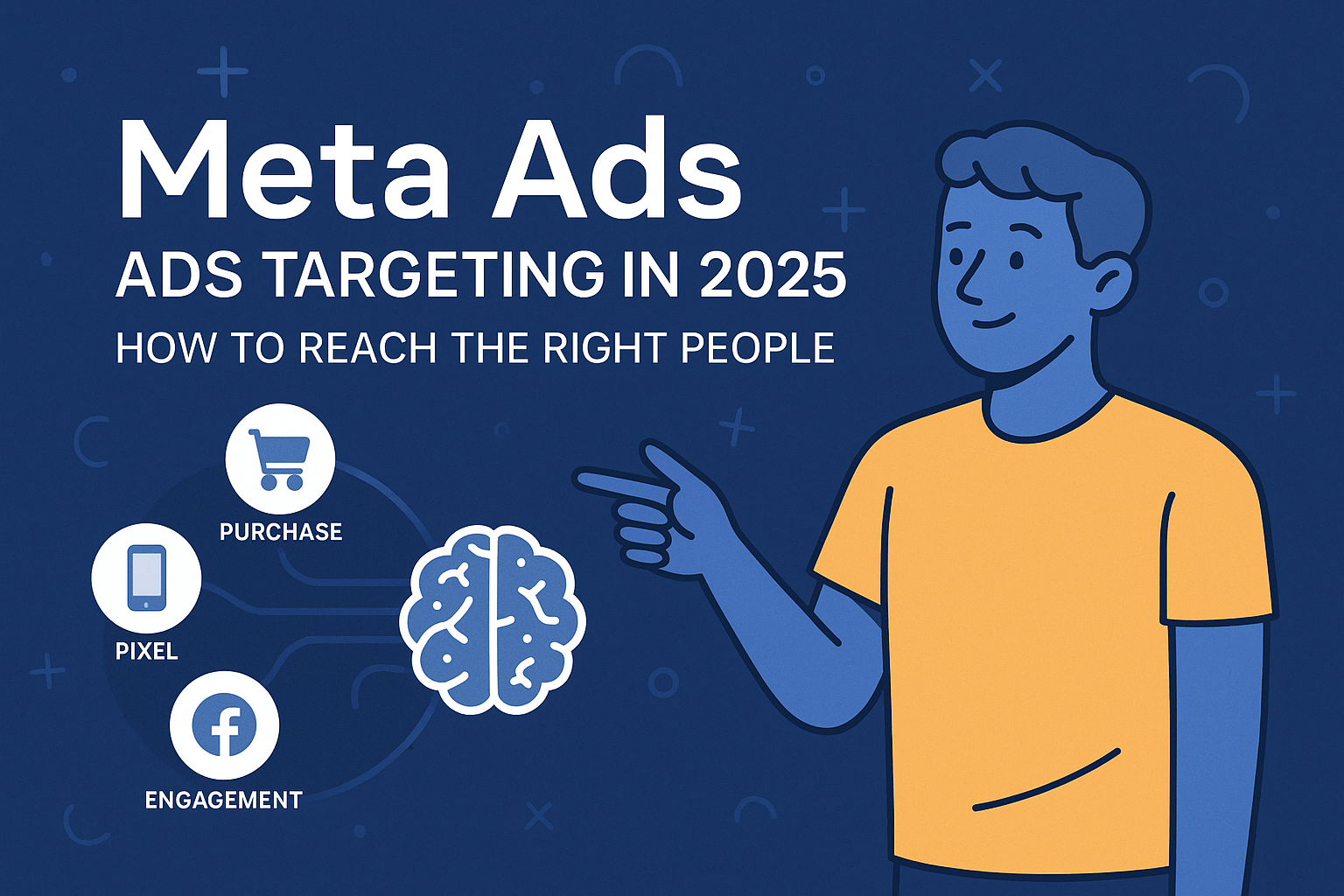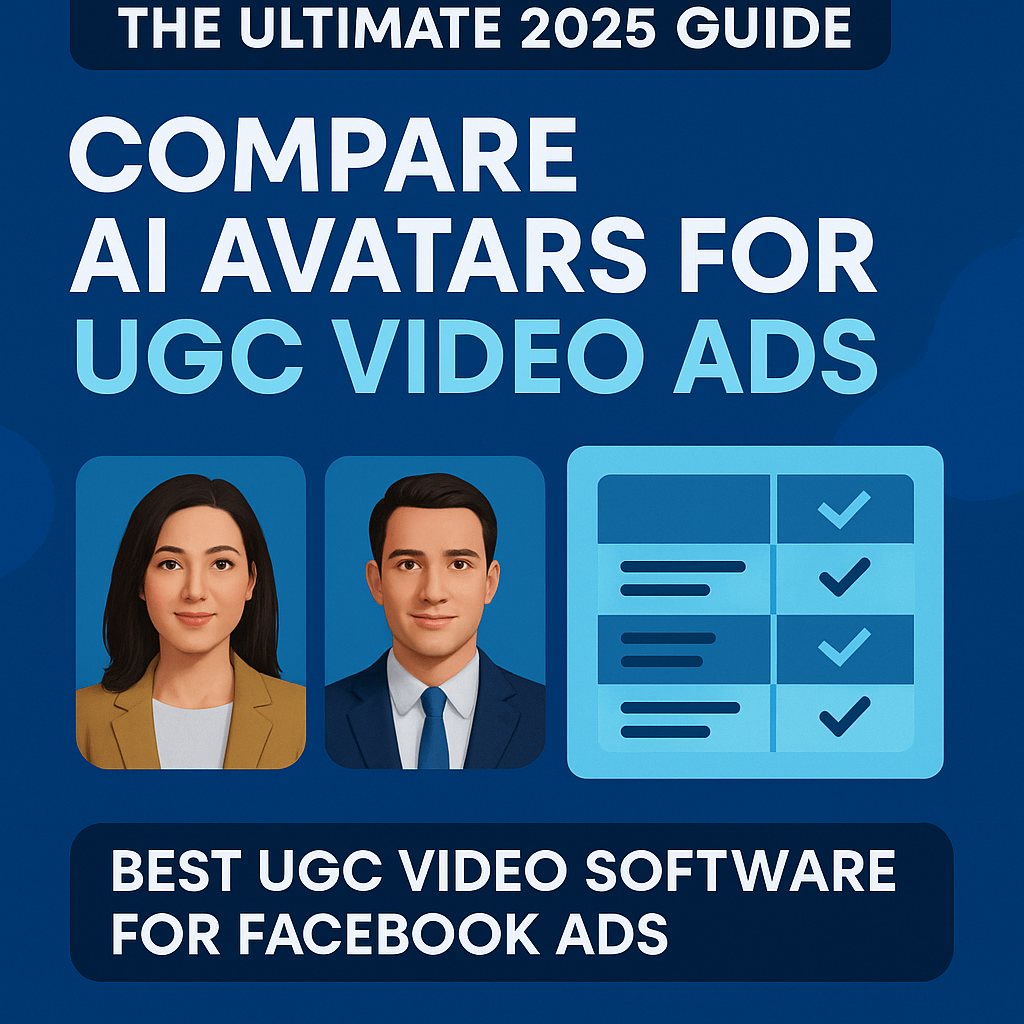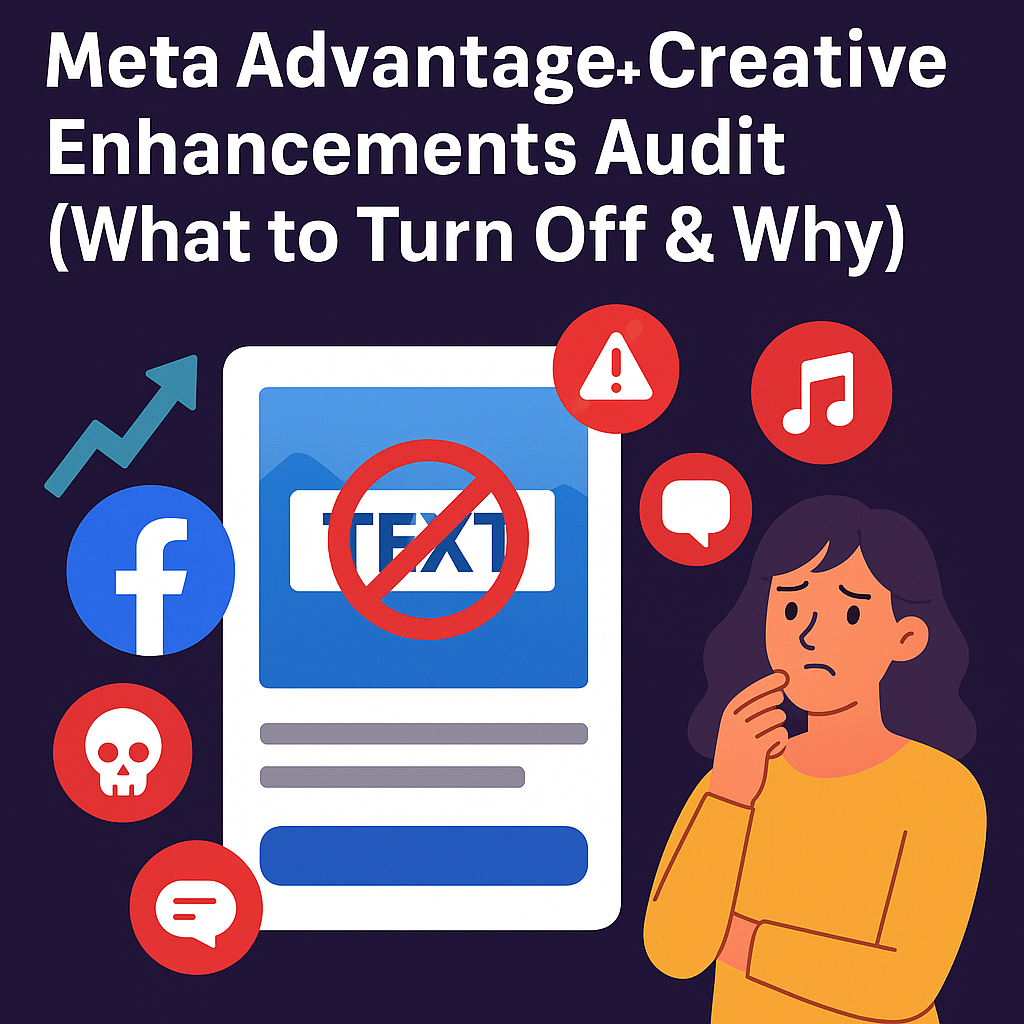For years, you’ve been told that success on Meta ads depends on meticulous ad targeting, obsessively layering interests, creating dozens of lookalike audiences, and segmenting by every possible demographic. You’ve been conditioned to believe that more control equals better results. But if you’re feeling that these old methods are now a frustrating and ineffective part of your workflow, you’re not wrong. They’ve become irrelevant, and they might even be hurting your performance.
This guide isn’t here to bully you into abandoning what you’ve always done. Instead, it’s designed to give you a “lightbulb moment” where you see your role as a marketer has fundamentally changed. The goal is to move you away from simply flipping targeting switches and toward a more productive, strategic role. You’ll learn how to work with the powerful Meta algorithm, giving it the right inputs to effectively reach the right people and scale your business with far less effort.
TL;DR:
If you’re still obsessing over Facebook ad targeting tweaks, it’s time to evolve. This modern guide to Meta ads explains how automation and machine learning have shifted the focus away from manual audience targeting. You’ll learn how Advantage+ Audience, audience expansion, conversion-focused optimization, and ad creative now play the biggest roles in helping you reach the right people and scale ad performance efficiently.
Table of Contents
Why Manual Ad Targeting Matters Less in Meta Ads
The most significant change in Meta’s ad platform is the move toward automation. What were once rigid audience filters are now often treated as mere suggestions by the Meta algorithm. This shift is driven by the platform’s advanced machine learning in ad delivery, which has become so sophisticated that it can find your ideal customer more effectively than you can with manual inputs alone. This shift is backed by Meta’s own Performance 5 Framework, which recommends simplifying ad set structure and leaning into automation to let the algorithm optimize delivery.
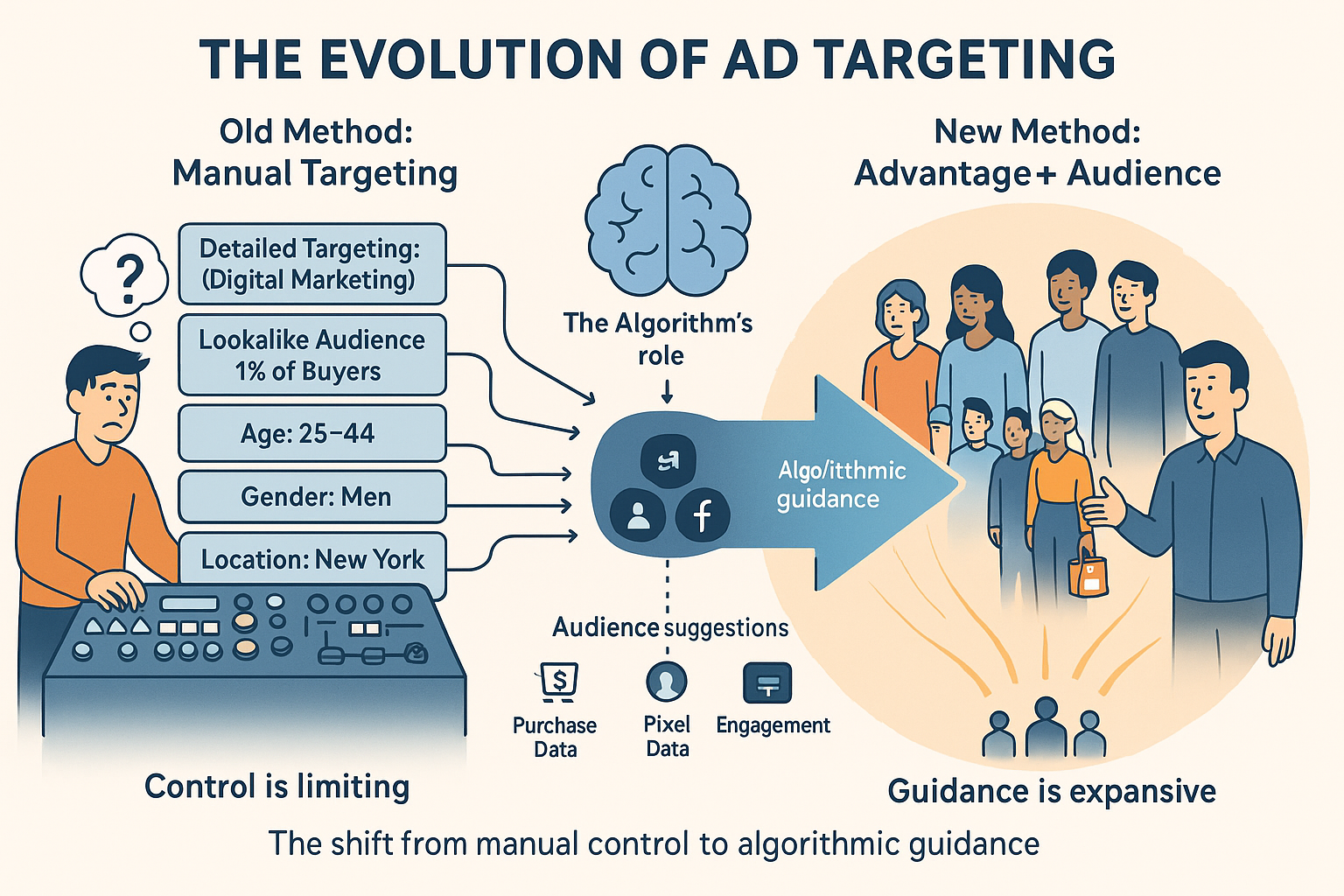
Advantage Detailed Targeting & Lookalike Audiences Explained
For years, advertisers believed that to target people interested in “digital marketing,” they had to select that interest in their ad set explicitly. Today, this is no longer the case. When you choose a conversion-focused objective, such as “Sales,” Meta’s algorithm is smart enough to identify users with a history of converting on similar products, regardless of whether you’ve provided any detailed targeting.
This is the core concept behind Advantage Detailed Targeting and Advantage Lookalike. These features are often automatically enabled when you’re optimizing for conversions on Meta ads, and their purpose is to allow for audience expansion. Instead of being a hard constraint, the interests you provide or the lookalike audience you create are used as a starting point. The algorithm will then dynamically expand beyond those inputs if it predicts that doing so will lead to better performance. In simple terms, your inputs are a guide, not a wall.
How Advantage+ Audience Helps Reach the Right People
The culmination of this shift is the Advantage+ Audience, a powerful, AI-driven targeting solution that simplifies the ad creation process. Instead of asking you to define a narrow audience, it encourages you to go broad. With a solid conversion event set up (e.g., a “Purchase” event on your website), the Meta algorithm will use a combination of your pixel data, past ad engagement, and real-time signals to build an audience for you.
This approach gives the algorithm the freedom to find unexpected pockets of high-performing users that you would have missed with manual targeting. For example, a business selling men’s clothing might find that without any age or gender restrictions, its ads are shown to a small percentage of women. The algorithm, in this case, has identified women who are likely to purchase the clothing as a gift, a high-value audience that a manual filter would have excluded.
How to Reach the Right People with Meta Ads in 2025
So, if manual inputs are becoming irrelevant, where should you, the modern marketer, focus your energy? The answer lies in providing the algorithm with the right strategic inputs. Your role has evolved from a manual controller to a strategic partner, and these are the pillars of that partnership.
Your Performance Goal is the Ultimate Targeting Tool
The single most important signal you can give the Meta algorithm is your performance goal. This is the new, primary form of ad targeting. If your goal is “Sales” with a “Purchase” conversion event, the algorithm’s entire focus will be on finding people most likely to buy your product. It will analyze a user’s behavior and history and then bid to show your ad to those with the highest purchase probability.
Conversely, if your goal is “Traffic” to get the most clicks on your link, Meta will find people who are “click-happy.” These users are often not the same people who are likely to make a purchase. They might click a link, but they are unlikely to convert. The lesson is clear: your campaign objectives are the true north for the algorithm’s delivery, and selecting the right one is paramount to success.
The Foundation of Success: Conversion-Focused Optimization and Data
The magic of algorithmic targeting relies on a steady stream of high-quality data. To help the Meta algorithm understand who your ideal customer is, you need to provide it with signals from your most important user actions. This is why a well-configured Meta Pixel and Conversion API are non-negotiable. They are the conduits that send valuable first-party data back to Meta, informing the algorithm which users are viewing products, adding items to their cart, or making a purchase.
This data is the fuel for conversion-focused optimization. Without it, the algorithm is essentially flying blind. For a new business, this can feel like a catch-22, as you need data to achieve good results but must run campaigns to gather that data. The best strategy is to start with a modest budget and a broad audience, focusing on gathering those initial conversion events. Over time, as the algorithm receives more data, its ability to identify high-value customers will improve dramatically, enabling more effective audience expansion.
Creative is Your New Targeting
Creative is your new targeting. Your images and copy now do what interests and demographics used to. The best creative naturally attracts your ideal customer and filters out everyone else.
Consider the vitamin brand Ritual. Instead of targeting “health-conscious women” with demographic inputs, their ads do the work. The visuals show real women in simple, everyday settings, often without heavy makeup, speaking directly to the camera about their personal journey with supplements.
The copy uses phrases like “Finally, supplements you can actually feel good about” and “Rituals are personal.” This language and imagery, a stark contrast to the sterile, over-scientific ads of the past, immediately attracts an audience that values authenticity, transparency, and simplicity in their wellness routine.
A consumer looking for a quick-fix pill or a bodybuilder’s supplement would simply scroll past, effectively “filtering” themselves out of the audience. This type of “creative targeting” is more effective than any manually set interest or demographic filter.
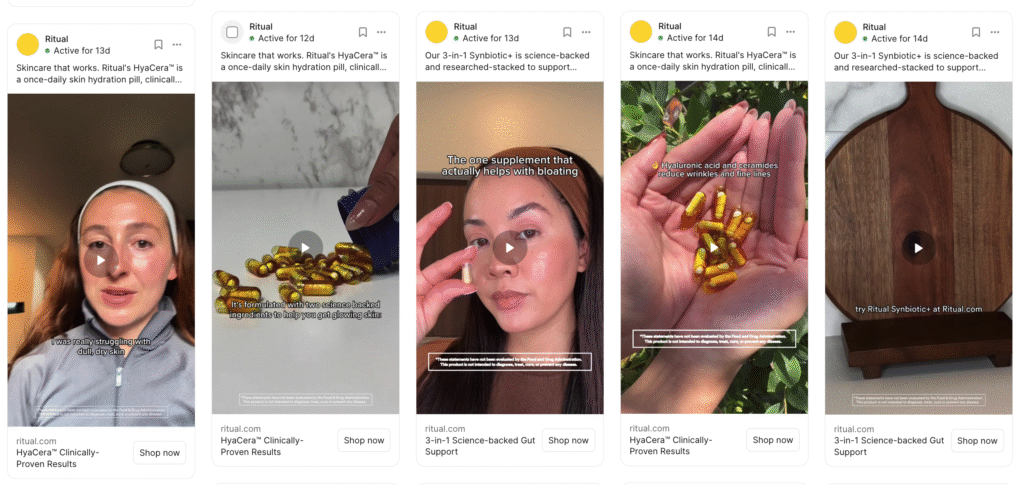
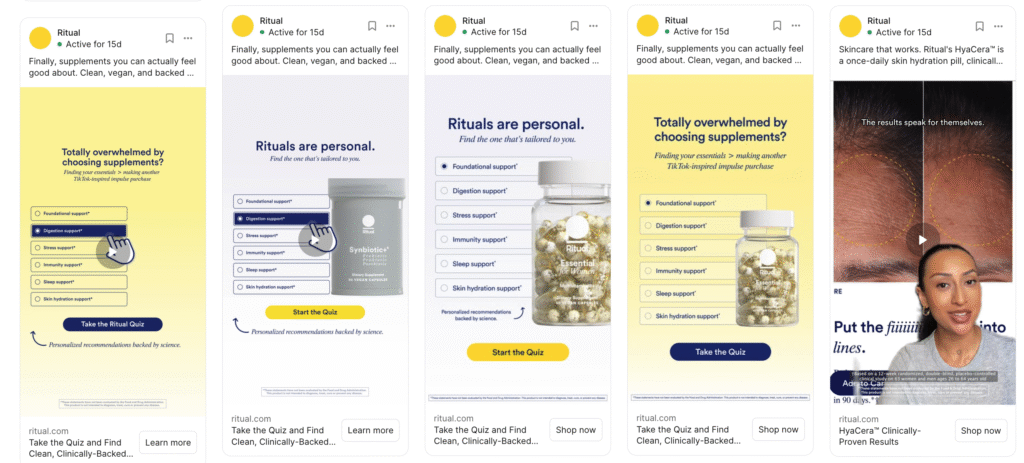
Why Meta’s Algorithm Outperforms Manual Targeting
Many advertisers still wonder, “why targeting inputs matter less in Meta ads” today. The answer is simple: the algorithm is smarter than we are. Your old targeting methods were based on fixed, static guesses about your audience. The Meta algorithm, however, is a dynamic learning machine. It uses millions of real-time signals, from a user’s recent clicks to their on-platform behavior, to predict who is most likely to convert in a fraction of a second. This level of accuracy and real-time adjustment is impossible for a human to replicate manually, making the algorithm’s predictions far more accurate and efficient than any manual setup.
What Is Advantage+ Audience?
Think of Advantage+ Audience as your co-pilot for ad targeting. It’s a key feature of Meta’s simplified campaign structure that takes your audience targeting strategies to the next level. Instead of manually defining a narrow audience, you give the algorithm optional “suggestions” like a lookalike audience or detailed interests. From there, the system’s advanced machine learning takes over, dynamically expanding the audience to find the highest-value users for your campaign goal. It’s the fastest, most efficient way to get better results with less manual effort.
Simplifying Your Meta Ads Targeting Strategy: What Works Now
Now that you understand the principles of modern Meta ads targeting, here are some practical strategies to implement this new approach.
How to Use Audience Controls and Suggestions Effectively
While the shift is away from manual inputs, some controls still matter. Meta makes a key distinction between Audience Controls and Audience Suggestions.
Audience Controls are hard constraints that you should use sparingly. These include location (e.g., targeting a specific country or state) and minimum age (e.g., for age-restricted products). Use these only when they are absolutely necessary for your business.
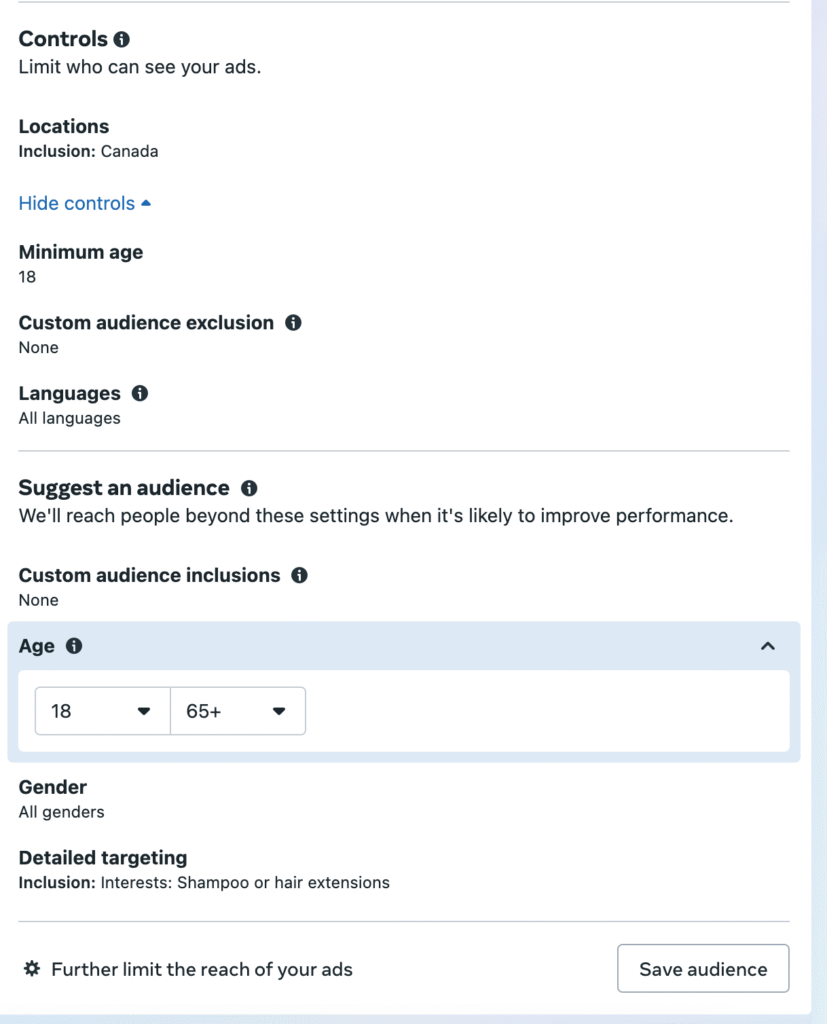
Audience Suggestions are your old friends, detailed targeting and lookalikes. You can still provide these, especially for a new account to give the algorithm a starting point. But remember, the goal is to see if the Meta algorithm can achieve better performance through audience expansion.
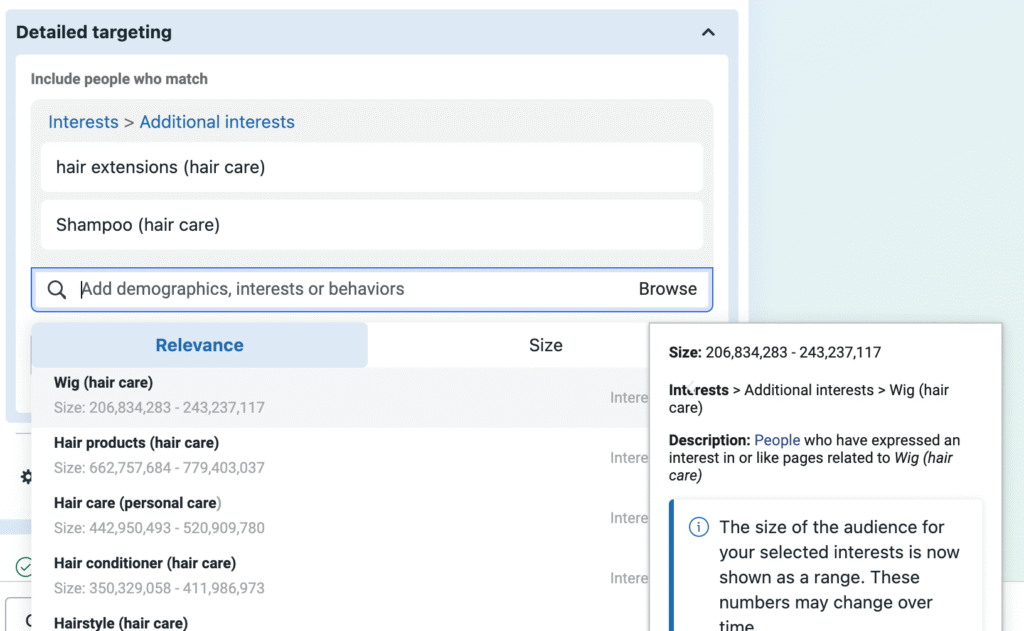
The Evolving Role of Remarketing
For years, a separate remarketing campaign for website visitors or past customers was a cornerstone of any good strategy. Today, this is often redundant. The Meta algorithm knows that people who have engaged with your brand are more likely to convert, and it will prioritize showing your ads to these users within your main conversion-focused campaigns.
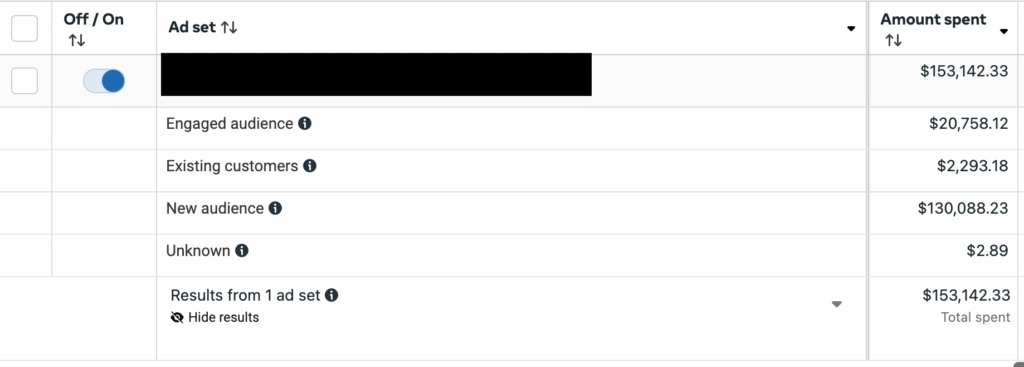
However, remarketing still has its place as a strategic exception. You might use a specific, highly segmented remarketing campaign for a high-ticket item, or to promote a unique offer to a list of past purchasers. For more on Meta ad creative best practices that drive conversions, check out our full guide. For most general campaigns, a single broad campaign with a conversion objective will naturally handle remarketing for you, often more efficiently than a manually-created ad set optimization.
Focusing on the Learning Phase for Better Ad Performance
The learning phase is a crucial period where the Meta algorithm learns about your audience and their behavior. The quality of your initial conversions during this phase is paramount. For lead generation, you can influence this learning by using forms with specific qualifying questions.
Testing periods often suffer from over-management: splitting ad sets by placement, switching off ‘underperforming’ segments too early. Previous tests on our accounts have shown that this often harms performance by fragmenting the budget and confusing the learning algorithm, resulting in inconsistent results.
Conclusion
The era of obsessing over manual ad targeting on Meta is over. The new game is one of strategic inputs, not tactical switches. Your role has evolved to be a smart partner to the Meta algorithm, not a manual controller. To reach the right people in today’s landscape, you must:
- Choose the right campaign objectives to align with your business goals.
- Provide the algorithm with rich conversion data via the Meta Pixel and Conversion API.
- Use your ad creative and copy as the primary filtering tools.
- Embrace automated features like Advantage+ Audience and allow for audience expansion.
By simplifying your Meta ads targeting strategy and focusing on these key areas, you’ll free yourself from a time-consuming and often ineffective process. You will unlock the true power of machine learning in ad delivery and find a more scalable, effective way to grow your business. The future of Meta advertising isn’t about more controls; it’s about smarter controls, and the courage to let the algorithm do what it does best.
FAQ
How can I reach the right people if I don’t use detailed interests?
Many marketers worry that removing interests will kill performance. But in 2025, Meta’s algorithm relies on much smarter signals. It uses a variety of signals beyond interests, including real-time user behavior, past conversion data, and engagement history with similar content. When you select a conversion objective, the algorithm prioritizes finding users who have demonstrated a high propensity to complete that specific action, making detailed interests largely redundant for this purpose.
What is the difference between a broad audience and using Advantage+ Audience?
A broad audience is a manual setup where you intentionally leave the targeting inputs blank to give the algorithm a wide canvas. Advantage+ Audience is a specific feature within Meta’s platform that automates this process by using your data (pixel, past conversions) as a starting point, and then dynamically expanding to find the highest-performing users.
Is it still necessary to create a separate ad set for my remarketing audience?
For many businesses, a separate remarketing ad set is no longer necessary. The Meta algorithm naturally prioritizes showing ads to people who have recently engaged with your brand because they are more likely to convert. For most campaigns, a single broad ad set with a conversion objective will automatically handle both prospecting and remarketing.
What’s the best targeting strategy for conversion-focused Meta ads?
The most effective audience targeting strategies for conversion-focused Meta ads in 2025 rely on giving the algorithm the freedom to perform. The best strategy is to use a conversion goal (e.g., Purchase), feed the algorithm clean data via Pixel + CAPI, and rely on Advantage+ Audience for smart scaling.
How do I know if the Meta algorithm is actually finding my ideal customers?
The best way to know is by looking at your campaign results. If you are optimizing for a Purchase event, are you seeing an increase in sales? If you are optimizing for leads, are the leads you are getting of high quality? Use the u0022Breakdownu0022 feature in Ads Manager to see if your results are coming from the demographics you expect, but don’t be afraid if the algorithm finds valuable customers outside of your initial assumptions.

